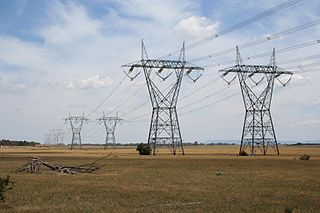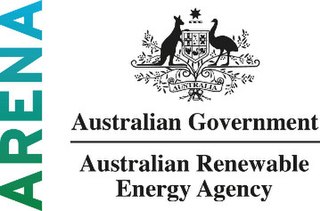
A zero-emission vehicle, or ZEV, is a vehicle that does not emit exhaust gas or other pollutants from the onboard source of power. The California definition also adds that this includes under any and all possible operational modes and conditions. This is because under cold-start conditions for example, internal combustion engines tend to produce the maximum amount of pollutants. In a number of countries and states, transport is cited as the main source of greenhouse gases (GHG) and other pollutants. The desire to reduce this is thus politically strong.

Grid energy storage is a collection of methods used for energy storage on a large scale within an electrical power grid. Electrical energy is stored during times when electricity is plentiful and inexpensive or when demand is low, and later returned to the grid when demand is high, and electricity prices tend to be higher.

Vehicle-to-grid (V2G) describes a system in which plug-in electric vehicles (PEVs) sell demand response services to the grid. Demand services are either delivering electricity to the grid or reducing the rate of charge from the grid. Demand services reduce the peaks in demand for grid supply, and hence reduce the probability of disruption from load variations. Vehicle-to-load (V2L) and Vehicle-to-vehicle (V2V) are related, but the AC phase is not synchronised with the grid, so the power is only available to "off-grid" load.

Icon Water Limited, trading principally as Icon Water, is a water and wastewater public utility that is an Australian Capital Territory-owned corporation. The company provides drinking water and wastewater services to the ACT. Icon Water is also a 50% owner of ActewAGL, a multi-utility provider of electricity and gas services in the ACT and south-east New South Wales. Icon Water Limited is also the owner of Bendora Dam, Corin Dam, Cotter Dam and Googong Dam in New South Wales. Water is gravity fed to Canberra via the Bendora Gravity Main and pumped from Googong Dam. Icon Water operates, and maintains 50 service reservoirs, 25 pump stations, 2 water treatment plants, 27 sewage pumping stations, 4 sewage treatments plants, over 3,400 km of sewer pipelines and over 3,400 km of water pipelines.
Alinta Limited was an Australian energy infrastructure company. It has grown from a small, Western Australia-based gas distributor and retailer to the largest energy infrastructure company in Australia. It was bought in 2007 by a consortium including Singapore Power and various parties which include the now defunct Babcock & Brown funds.
A virtual power plant (VPP) is a system that integrates multiple, possibly heterogeneous, power sources to provide grid power. A VPP typically sells its output to an electric utility. VPPs allow energy resources that are individually too small to be of interest to a utility to aggregate and market their power. As of 2024, VPPs operated in the United States, Europe, and Australia.
The energy policy of India is to increase the locally produced energy in India and reduce energy poverty, with more focus on developing alternative sources of energy, particularly nuclear, solar and wind energy. Net energy import dependency was 40.9% in 2021-22.

AGL Energy Ltd is an Australian listed public company involved in both the generation and retailing of electricity and gas for residential and commercial use. AGL is Australia's largest electricity generator, and the nation's largest carbon emitter. In 2022, 83% of its energy came from burning coal. It produces more emissions as a single company than the nations of New Zealand, Portugal or Sweden, according to its largest shareholder, Mike Cannon-Brookes, who named it "one of the most toxic companies on the planet".

Solar power is a major contributor to electricity supply in Australia. As of December 2023, Australia's over 3.69 million solar PV installations had a combined capacity of 34.2 GW photovoltaic (PV) solar power. In 2019, 59 solar PV projects with a combined capacity of 2,881 MW were either under construction, constructed or due to start construction having reached financial closure. Solar accounted for 12.4% of Australia's total electrical energy production in 2021.

Renewable energy in Australia is mainly based on biomass, solar, wind, and hydro generation. Over a third of electricity is generated from renewables, and is increasing, with a target to phase out coal power before 2040. Wind energy and rooftop solar have particularly grown since 2010. The growth has been stimulated by government energy policy in order to limit the rate of climate change in Australia that has been brought about by the use of fossil fuels. Pros and cons of various types of renewable energy are being investigated, and more recently there have been trials of green hydrogen and wave power.
A grid-tied electrical system, also called tied to grid or grid tie system, is a semi-autonomous electrical generation or grid energy storage system which links to the mains to feed excess capacity back to the local mains electrical grid. When insufficient electricity is available, electricity drawn from the mains grid can make up the shortfall. Conversely when excess electricity is available, it is sent to the main grid. When the Utility or network operator restricts the amount of energy that goes into the grid, it is possible to prevent any input into the grid by installing Export Limiting devices.

Energy in Victoria, Australia is generated using a number of fuels or technologies, including coal, natural gas and renewable energy sources. Brown coal, historically, was the main primary energy source for the generation of electricity in the state, accounting for about 85% of electricity generation in 2008. The amount of coal-fired power has decreased significantly with the closure in 2017 of the Hazelwood power station which supplied around 20% of Victoria's electricity, and to a lesser extent with the exit of Anglesea power station in 2015. Brown coal is one of the largest contributors to Australia's total domestic greenhouse gas emissions and a source of controversy for the country. Australia is one of the highest polluters of greenhouse gas per capita in the world.

SGSP (Australia) Assets Pty Ltd (SGSPAA), trading as Jemena, is an Australian company that owns, manages or operates energy infrastructure assets in the eastern states of Australia including Queensland and New South Wales, and gas pipelines and gas and electricity distribution networks in Victoria and the Northern Territory. It is 60% owned by State Grid Corporation of China and 40% by Singapore Power.

The Australian Renewable Energy Agency (ARENA) is an independent agency of the Australian federal government, established in 2012 to manage Australia's renewable energy programs, with the objective of increasing supply and competitiveness of Australian renewable energy sources.

The adoption of plug-in electric vehicles in Australia is driven mostly by state-based electric vehicle targets and monetary incentives to support the adoption and deployment of low- or zero-emission vehicles. The monetary incentives include electric vehicle subsidies, interest-free loans, registration exemptions, stamp duty exemptions, the luxury car tax exemption and discounted parking for both private and commercial purchases. The Clean Energy Finance Corporation, energy providers, car loan providers and car insurance providers also offer their own financial incentives for electric vehicle purchases including Macquarie Bank offering the lowest electric car loan of 2.99%.

Energy produced in the Australian Capital Territory mainly consists of solar electricity. Electricity consumed in the Australian Capital Territory mainly comes from the national power grid through substations at Holt and Fyshwick. The ACT currently mandates that 100 percent of its electricity, will be supplied from renewable sources by 2020. The ACT has five solar farms capable of generating about 56.3 megawatts. From 1913 until the mid 1950s some power was produced from the Kingston Powerhouse, a thermal power station in Kingston.
The Eastern Gas Pipeline (EGP) is a 797 km (495 mi) natural gas pipeline. It is a key supply artery between the Gippsland Basin in Victoria and New South Wales, Australia. The EGP is currently operated by Jemena.
Tasmania, as an advanced economy with a globally high standard of living, uses a great deal of energy. Distinctive features of energy use in Tasmania include the high fraction of hydroelectricity usage, the absence of coal-fired electrical generation, relatively light usage of natural gas, particularly for domestic use, and a wide use of domestic wood-burning stoves. Energy production through hydroelectricity has been politically contentious, and conflicts over Tasmanian hydroelectric projects were integral to the formation of Green parties in Australia and across the world.











